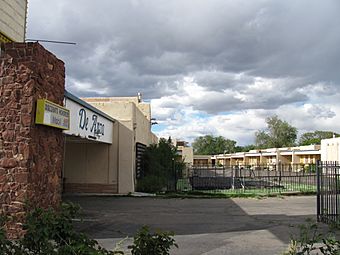De Anza Motor Lodge facts for kids
|
De Anza Motor Lodge
|
|

De Anza Motor Lodge in 2010
|
|
| Location | 4301 Central Ave. NE, Albuquerque, New Mexico |
|---|---|
| Built | 1939 |
| NRHP reference No. | 04000375 |
Quick facts for kids Significant dates |
|
| Added to NRHP | April 30, 2004 |
The De Anza Motor Lodge was a famous motel located on the historic U.S. Route 66 in Albuquerque, New Mexico. It was built in 1939 by Charles G. Wallace. He was a local trader who sold Zuni art and pottery.
Wallace owned the motel until 1983. He decorated it with many pieces of Native American art. This included special murals by Zuni artist Tony Edaakie in a basement room. The city of Albuquerque bought the motel in 2003. Most of the buildings were taken down in 2017–2018. A new hotel and apartment complex is being built there. Some original parts, like the sign and the Zuni murals, were saved.
Contents
What Was the De Anza Motor Lodge?
The De Anza Motor Lodge was a motel built in 1939. It was located on U.S. Route 66, a very important road for travelers. The motel was named after Juan Bautista de Anza, a Spanish governor. It was known for its unique Native American art.
Who Built the De Anza Motor Lodge?
Charles Garrett Wallace built the De Anza Motor Lodge. He came to New Mexico in 1919. He became a well-known trader with the people of Zuni Pueblo. In the 1930s, during the Great Depression, fewer people were buying art. Wallace saw that many tourists were traveling on Route 66. He decided to build a motel to expand his business.
He partnered with S.D. Hambaugh to build the motel. It opened in 1939 with 30 rooms. Soon after, Wallace bought out Hambaugh and became the sole owner.
How Did the Motel Change Over Time?
After World War II, Wallace made the De Anza bigger and more modern. He increased the number of rooms to 67. He also added a cafe called the Turquoise Room. This cafe had a special floor made of terrazzo with turquoise and silver pieces.
A basement conference room was also added. Wallace asked Zuni artist Tony Edaakie to paint two large murals there. These murals showed the Shalako festival. They were finished in 1951 and are very special examples of Zuni art.
What Happened to the De Anza Motor Lodge?
Wallace sold the De Anza in 1983. The motel changed owners several times and eventually closed. In 2002, there was a plan to tear down the motel. The city of Albuquerque stepped in to save it. They bought the property in 2003 for $891,000.
However, plans to fix up the motel did not work out. The building continued to get worse. In 2017, the city approved a new project. Most of the De Anza was taken down in 2017–2018. A new hotel and apartment complex is being built. Only a few parts of the old motel were kept. These include two smaller buildings, the motel sign, and the important Zuni murals.
The De Anza Motor Lodge was recognized for its history. It was added to the New Mexico State Register of Cultural Properties in 2003. It was also added to the National Register of Historic Places in 2004. In 2012, it became a Historic Landmark for the city of Albuquerque.
Images for kids
-
Juan Bautista de Anza, the person the motor lodge was named after.


